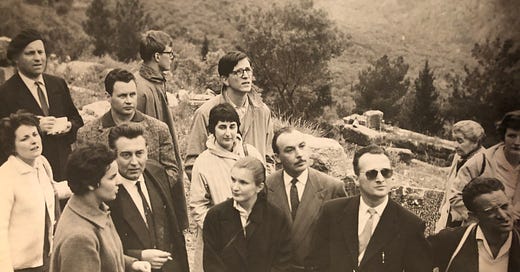Two Houses is a newsletter of stories about art, feminism, grief, and Time excavated from the Soho loft where I grew up. Posts are free and illustrated with the work of my long-divorced parents, the painters Mimi Weisbord and Lennart Anderson.
My father, Lennart Anderson, drew a large head of Zeus for his grandson Atticus’s Lightening-Thief-themed birthday party. We used it to play Place the Wreath on Zeus’s Head, a variation of Pin the Tail on the Donkey. Dad was half-blind with macular degeneration, but he enjoyed the challenge and tossed off the Greek head with pleasure at our picnic table using peripheral vision, large gestures, and a green marker. For his costume, we also dressed him as Zeus. He was all for it. In a draped sheet—white hair floating about his head with a bit of greenery—he presided over our lawn, towering above the children and most of the adults, smiling, majestic, enjoying the spirit of the day.
It’s a favorite memory.
But then later, as I was cleaning up, I admired the sketch and suggested I might hang onto it.
He turned his head to search my face and, still wearing the toga, leveled, “You’d better not!”
Dead serious. No further explanation.
The reprimand stung—first because I was in trouble with him and then because I felt embarrassed for him; he was acting like this markered sketch—little more than a party favor—would topple him from Mt. Olympus. Committed to feeling like a normal parent, I kept and considered that Zeus-head for a long time.
I’ve concluded that I was first introduced to this side of my father at about age three. He’d drawn me into a study for St. Mark’s Place, the large street scene he was then working on in his studio on our brownstone’s top floor. He drew me on the sidewalk, walking along with my head of curls, holding a lollipop.
I loved it. Every time I toddled into the studio, I asked to see it. Each time, he’d pull it from his flat files. Then, one day, he said he didn’t have it anymore. It wasn’t serious, he said, irritated and turning away.
Confused, I swallowed that rejection and never mentioned it to anyone. The message I absorbed was I’d bothered him too often. I doubted he’d thrown the drawing away; that was unthinkable. But for years, I poked around for it with no luck.
Since then, I’ve rubbed that moment up against later experiences. Now I know he didn’t want that sort of thing outsurviving him.
In 2021, I visited some very old friends of both my parents in Woodstock, New York. There, I was gifted drawings and studies by my father from the 1950s and stories of my parents' beginnings and behaviors. They knew I was excavating my mother’s loft, that I had found letters and paintings. They knew I wanted everything they could remember from when my parents were still together.
Edward Lazansky had a Woolley Fellowship in Paris while my parents were at the American Academy in Rome. He and Phyllis Tower visited them there, and they remained close years after they were all back in New York together. They recalled for me how angry it made Lennart to learn that other fellows at the Academy in Rome had raided the drawings he’d thrown away as he packed to move back to the States. He did not want that work representing him.

From what I can tell, Lennart did not keep sketchbooks. He did have drawing pads, but those are editable, and I’m certain he removed whatever he didn’t like. He’d say he didn’t want anything left behind that might “embarrass” him. (I think I read that somewhere, though I hear him saying it in my head.)
He also said that if a painting looks overworked, that just means it needs more work! Spoken with humor, conviction, and a kind of self-deprecating irony. He’d spend years, decades even, on a single picture. And yet, at the very end of his life, he told me he feared he’d not painted enough to be remembered.
My father was layered like his paintings.
Now I’m teasing apart those layers. That’s the job of the excavator. We dig to understand where we come from.
Lately, I’ve felt hesitant to write about Lennart. I feel like I have to get him exactly right. But he doesn’t sit still for me. I’m squinting at him, and he’s squirming around as I used to under his brushes.
Once, in a museum, he showed me what he loved about a Degas painting. The lip of the bowl was painted in two places, a double image. Neither was wrong, he said. Degas just left them.

(Yesterday, Kim found the head of Zeus rolled up in a closet.)




Eliza. I love that this Zeus is drawn with such a lived experience as an artist. “Lived”meaning full confidence of making each line just as it is on the paper. So glad Kim found it.
What a journey you are on! I know by the end you will know more about your parents - individually and together - as most of us will ever learn. And more about yourself, I suspect. Thank you for sharing with us.